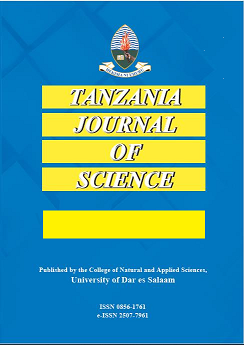Levels of pesticide residues in water, soil and sediments from southern Lake Victoria and its basin
Abstract
Water, sediment and soil samples collected from Southern Lake Victoria and its basin were analysed for 76 organochlorine, organophosphorous, carbamate and pyrethroid pesticide residues. The samples were collected from sampling stations in nine districts on the Tanzanian side of the lake, namely Mwanza, Sengerema, Geita, Ngudu, Misungwi, Magu, Bunda, Tarime and Musoma Districts. DDT and HCH residues were the only detected pesticides. The concentration of total DDT was up to 1.6 mg/L in water, 600 mg/kg dry mass in sediments and 20 mg/kg dry mass in soil. The concentration of total HCHs were up to 0.2 mg/L in water, 132 mg/kg dry mass in sediments and 59mg/kg dry mass in soil. Generally, higher levels of the residues were detected during the rainy seasons, thanin the dry seasons. These levels are generally low indicating that in Southern Lake Victoria and its basin pesticide pollution has not reached alarming levels. However, the present study shows that despite being banned for use in agriculture in Tanzania since 1992, DDT was still being used in some of the districts at the basin. Worse still, technical HCH, which contains only 10 - 15% of the active isomer, lindane, was commonly used in the area in spite of its being de-registered many years ago.


